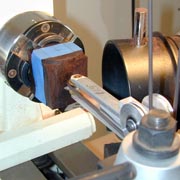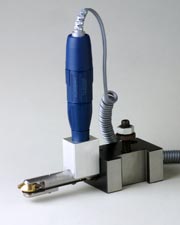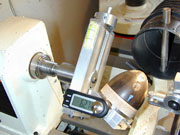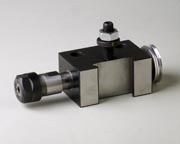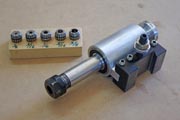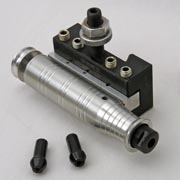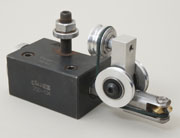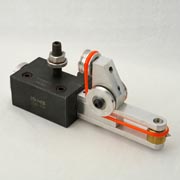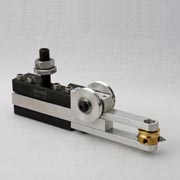A variety of cutting frames are used in ornamental turning.
These are unlike cutters used in any other industry,
and are highly specialized for cutting specific types of patterns.
Specialized chucks are used to hold the work for cutting.
It helps to have access to a mini metal lathe and a mini milling machine.
For an introduction to using such mini machines, see www.mini-lathe.com.
I don't make these for sale.
However, if you have questions about any of these (or suggestions for improvement),
please email me at: bill@billooms.com
Here's my latest Universal Cutting Frame (UCF) built with a Ram Products micromotor.
You can buy the micromotor handpiece and power supply from Treeline (in Utah) or directly from Ram Products for $265.
The pdf below gives a brief overview of how I built it along with some additional photos.
The 3D drawing file (for Google Sketchup free version) has dimensions and parts list.
Construction of a MicroMotor UCF
3D Drawing with dimensions and part numbers (use SketchUp free version)
I call this my Super Dome Chuck.
It's a like a traditional dome chuck but also has the ability to tilt the work rather than keeping it strictly at 90 degrees.
This permits any point on the surface of the work to be aligned at the center of a cutter.
I use this to cut a variety of patterns all over the surface of a shape.
The tilt includes a direct digital readout of the angle.
It can also be used in place of a traditional eccentric chuck.
SuperDomeChuck.pdf
3D Drawing with dimensions and part numbers (use SketchUp free version)
This is my 3nd generation Drill Frame with the bearings mounted directly in the boring tool holder.
It's made from an ER16 extension and uses standard ER16 collets.
The ER16 collets are much more precise than the collets that are used in the Foredom handpiece.
This also lets me use my 3/8" shank thread cutter without the need for an adapter.
DrillFrame3.pdf
This is my 2nd generation Drill Frame.
I've left this on the web site for reference only -- use the 3rd generation drill frame above.
It's made from an ER16 extension and uses standard ER16 collets.
The ER16 collets are much more precise than the collets that are used in the Foredom handpiece.
This also lets me use my 3/8" shank thread cutter without the need for an adapter.
DrillFrame2Construction.pdf
A drilling frame is used to mount a cutter that rotates like a drill bit.
It can also be used with other specialty cutters like an eccentric cutter.
The cutter is powered via a belt from an overhead motor to reduce vibration on the cutter.
You can build your own drilling frame using a modified hand-piece from a Foredom rotary tool.
Instructions for making this drilling frame are contained in the following pdf file:
Note: The newer 44T handpieces can be disassembled.
See the Foredom web site for a video on disassembly and an exploded parts list.
This will make modifying the handpiece much easier!
DrillFrameConstruction.pdf
This is probably my 3rd generation UCF.
It is much more sturdy than the predecessors having shorter arms made of steel.
The pulley arrangement can be moved back further in increments of 1/2" for those cases where I need a longer reach.
I don't have detailed instructions available at this time.
A Universal Cutting Frame (UCF) is similar to the HCF above.
However, the plane of the "flying head" can be rotated from horizontal to any angle up to vertical
(either clockwise or counter-clockwise).
The cutter is powered via a belt from an overhead motor to reduce vibration on the cutter.
Instructions for making the UCF is contained in the following pdf file:
UCFConstruction.pdf
A Horizontal Cutting Frame (HCF) is a "flying head" cutter that rotates only in a horizontal plane.
The cutter is a 3/16" rod that has been sharpened to a point, rounded, flat or some other profile.
An adapter can be used for 1/8" cutters.
The cutter is powered via a belt from an overhead motor to reduce vibration on the cutter.
Instructions for making the HCF is contained in the following pdf file:
HCFConstruction.pdf

